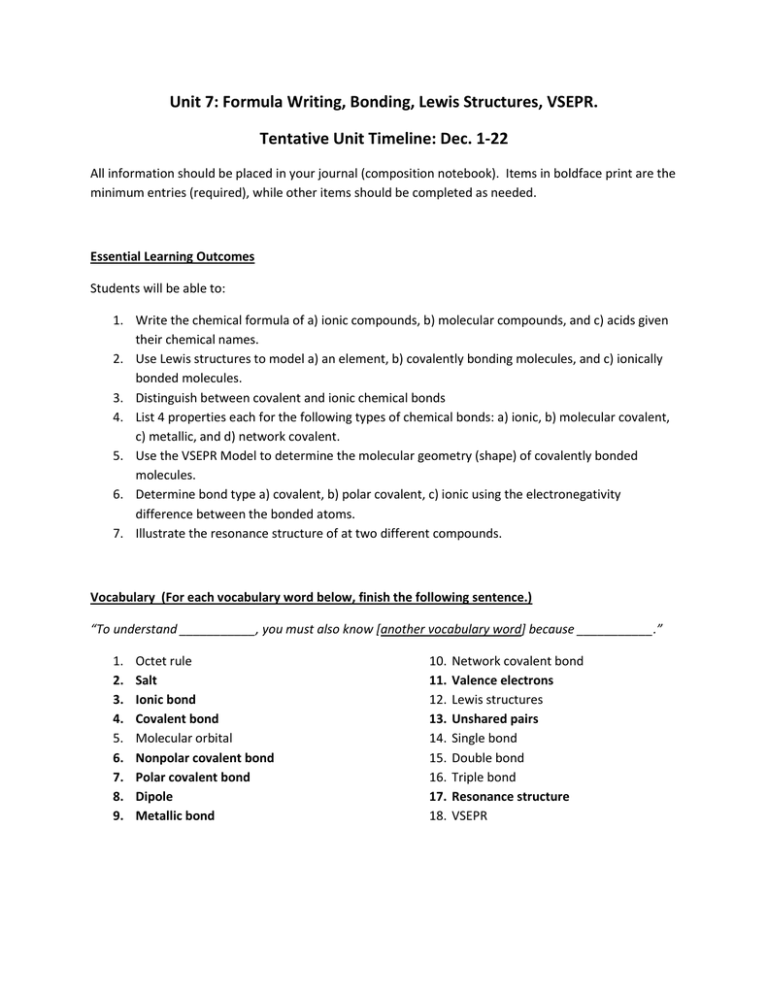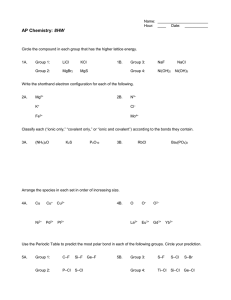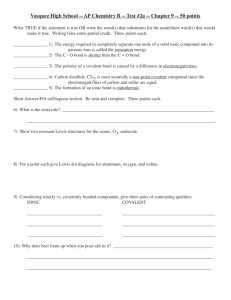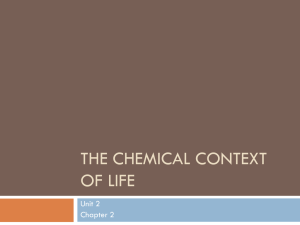Formulas_bonding_and_VSEPR Timeline
advertisement

Unit 7: Formula Writing, Bonding, Lewis Structures, VSEPR. Tentative Unit Timeline: Dec. 1-22 All information should be placed in your journal (composition notebook). Items in boldface print are the minimum entries (required), while other items should be completed as needed. Essential Learning Outcomes Students will be able to: 1. Write the chemical formula of a) ionic compounds, b) molecular compounds, and c) acids given their chemical names. 2. Use Lewis structures to model a) an element, b) covalently bonding molecules, and c) ionically bonded molecules. 3. Distinguish between covalent and ionic chemical bonds 4. List 4 properties each for the following types of chemical bonds: a) ionic, b) molecular covalent, c) metallic, and d) network covalent. 5. Use the VSEPR Model to determine the molecular geometry (shape) of covalently bonded molecules. 6. Determine bond type a) covalent, b) polar covalent, c) ionic using the electronegativity difference between the bonded atoms. 7. Illustrate the resonance structure of at two different compounds. Vocabulary (For each vocabulary word below, finish the following sentence.) “To understand ___________, you must also know [another vocabulary word] because ___________.” 1. 2. 3. 4. 5. 6. 7. 8. 9. Octet rule Salt Ionic bond Covalent bond Molecular orbital Nonpolar covalent bond Polar covalent bond Dipole Metallic bond 10. 11. 12. 13. 14. 15. 16. 17. 18. Network covalent bond Valence electrons Lewis structures Unshared pairs Single bond Double bond Triple bond Resonance structure VSEPR Textbook Reading (For #1: take personal notes. For #2: Fill out Graphic Organizer. For #3: See attached sheet for directions.) Chapter 6: Covalent Compounds. 1. Section 1: Covalent Bonds. a) Sharing Electrons,p.190-191 b) Electronegativity and Covalent Bonding, p. 194-196 c) Electronegativity and Bond Types, p. 196-197 2. Section 2: Drawing and Naming Molecules. a) Lewis Electron-Dot Structures, p. 199-203 b) Multiple Bonds, p.205-206 c) Naming Compounds, p.206-207 3. Section 3: Molecular Shapes. a) Determining Molecular Shapes, p. 208-211 b) Molecular Shape Affects a Substance’s Properties, p.212-213 Other reading selections 1. Demystifying Gross Stuff (Moodle article and video) Practice Problems 1. 2. 3. 4. Standard Prep Test; prob. 7-11, p.186-187 Section Review; prob. 4, 6, 10, 12 p. 207 Section Review; prob. 3, 5, 7, 8, 10, 11. P. 213 Chap. Review, prob. 6, 13, 17, 26, 31a, 31d, 31e, 45, 46 p. 216-218 Extra Journal Entry Possibilities HONORS Chemistry: the underlined practice problems are for you! GENERAL Chemistry: the bolded practice problems are for you! Other vocabulary words #1 and #2 Textbook Readings Practice worksheet on Moodle Research a following topic(s), gather data and display learning in journal (cite sources). How Charles Goodyear “accidently” invented the most commonly known polymer, vulcanized rubber Find out what free radicals are, what causes them and what can be done to prevent free radicals from damaging your body (from a health point of view). Explain how microwave ovens take advantage that some molecules in food are polar to heat up your leftovers. How chemists are making single molecule inventions for practical applications. For an idea, log onto Moodle and read “tiniest electric car” article. Write a 2 paragraph bio on Linus Pauling. Explain how he applied his knowledge on chemical bonds and structures to proteins and other large biochemical molecules. He also investigated the mechanism of sickle cell anemia. Explain how multiple bonds allow unsaturated fats to be solids at room temperature. Find the molecular structure of sucralose (Splenda©) and explain why your body cannot process it, thus making it a dieters dream! Internet Resources 1. On Moodle Graded Summative Assessment: Thurs. Dec. 22 Textbook Reading Section 2: make this organizer in your journal and fill out each surrounding bubble with one main point. Lewis Electron Dot Structures Textbook Reading Section 3: A good reader will ask questions before, during and after reading a text. Good readers ask questions to: clarify meaning, speculate about text yet to be read, show skepticism, determine the author’s intent or style, locate a specific answer, consider rhetorical questions that will take their understanding deeper into the text. Good readers use questions to focus their attention on ideas, events or other text elements they may want to remember. (Keene, E., & Zimmermann, S. (2007) Mosaic of Thought: The Power of Comprehension Strategy Instruction, 2nd Edition. Heinemann, pp. 135-6.) Section 3: Molecular Shapes. a) Determining Molecular Shapes, p. 208-211 b) Molecular Shape Affects a Substance’s Properties, p.212-213 BEFORE READING- based off the titles above, generate 2 questions that the author may answer in the text reading. DURING READING - generate 4 questions that you may have for the author as you read the text. AFTER READING – What is the most important, unresolved question that you have for the author? Created by: Veronica Giese, Merrill Area Public Schools






